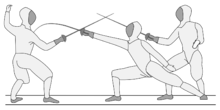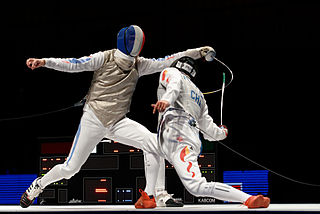
Tactics are very important to playing well in modern fencing and although technique is important in the sport, using an array of tactics will help fencers make the most of that technique.

Tactics are very important to playing well in modern fencing and although technique is important in the sport, using an array of tactics will help fencers make the most of that technique.

Offensive bladework consists of the various means of scoring a touch on an opponent. The straight attack is a direct extension towards valid target. As it is easily defended against, fencers often use numerous feints to deceive their opponent into parrying and then disengage around the blade. As a preparation for an attack, fencers may execute a prise de fer, or attack on the blade. This includes the simple beat, a sharp rap on the opponent's blade, and the more complex bind, in which the fencer forces the opponent's blade to a different line.
Composed of one move (a thrust, lunge or fleche), the simple attack is normally countered with a parry riposte, parrying (blocking or pushing aside) the opponent's blade and then attacking with this tactic. It can also be countered with a thrust in some situations. They are most effective when the distance between the fencers is small enough that the opponent cannot execute a parry riposte. Often fencers will try to close distance before mounting a simple attack to use this to their advantage. Sometimes, a fencer will make a simple attack and when the opponent parries, the fencer can then make a counter parry and riposte.
The combined attack (also known as the compound attack) can be quite effective, despite its vulnerability to counter-attack. A fencer using the compound attack makes a feint, prompting the opponent to parry and makes an indirect attack in response.
This attack is where you point your blade at your opponent. Your opponent will try to parry it, but you will disengage and touch.

A fencer deflects or blocks the opponent's blade with their own to defend themselves. This is usually followed by a riposte.
The nine classical parries comprise basic bladework. The first parry that most fencers learn is quarte, known commonly as "parry four". Parries are named for the line that they defend from attack: parry four would defend line four, which is the high inside line.
The parry riposte uses the strength of one's own blade to avoid the opponent's. After performing it, the fencer then counters the attack with a combined attack which would force the opponent to parry, allow you to counter parry the opponent's blade, and allow you to penetrate their next parry to win.
An offensive action executed into an opponent's attack. A fencer might choose to counterattack if they believe their opponent's attack will miss, or they might combine the counterattack with an evasive action (such as ducking beneath the opponent's attack) or simultaneously using their blade to deflect their opponent's attack during the counterattack (called a counterattack "in opposition").

In a fencing bout, a great deal depends on being in the right place at the right time. Fencers are constantly manoeuvring in and out of each other's range, accelerating, decelerating, changing directions and so on. All this has to be done with minimum effort and maximum grace, which makes footwork arguably the most important aspect of a fencer's training regimen. In fact, in the first half of the 20th century it was common practice to put fencers through six months to a year of footwork before they were ever allowed to hold a sword. This practice has now been largely abandoned.
Modern fencing tends to be quite linear. This is due to the width of the piste— no more than 2 m — and rules dictating a halt once fencers come into contact, pass each other, or turn their backs.
These rules may reflect older dueling styles and the changing nature of weapons: Sideways movement, which was a common defense against an attack with a comparatively unwieldy weapon like the rapier, became an unreliable tactic when faced with smaller, much lighter weapons. In contemporary sport fencing defense by footwork usually takes the shape of moving either directly away from your opponent (out of his/her range) or directly towards him/her (making the attack "overshoot").


The fencing stance and movements may appear artificial, but they have evolved over centuries of trial and error to afford optimal protection and mobility. Fencers tend to stand somewhat side-on to the principal direction of movement (the fencing line), leading with the weapon side (right for a right-hander, left for a left-hander). In this fencing stance the feet are a shoulder-width or more apart with the leading foot forward and the trailing foot at right angles to it. Finally, the knees are well bent and the center of gravity is kept midway between the heels. The fencer is now in a position where he/she is well balanced, able to use his/her leg muscles to generate rapid bursts of speed and change directions with comparative ease. In foil and épée, particularly, this stance decreases the vulnerable target area. Further, and more importantly, it maintains balance and ease of movement both forward and backward.
The most common way of delivering an attack in fencing is the lunge, where the fencer reaches out with his/her front foot and straightens his/her back leg. This maneuver has the advantage of allowing the fencer to maintain balance while covering far more distance than in a single step, yet still allowing a return to the more defensive fencing stance.
Sometimes fencers do take the more "natural" kind of steps, where the back foot passes the front foot. These are usually referred to as cross-steps . While cross-steps do have the advantage of range and speed, they may put a fencer in an awkward and frequently unbalanced position mid-step.
A somewhat exaggerated version of the cross-step, sometimes used to deliver an attack in foil or épée, is the flèche ("arrow" in French). In the flèche, the fencer leans forward and takes a long running cross-step, generating most of the thrust with his/her front leg. Ideally, the hit delivered with a flèche should arrive as or just before the fencer's front foot hits the ground. When (as often happens) the flèching fencer runs past the defender the defender is allowed to finish a defensive action, generally a riposte following a parry.
In sabre forward cross-steps were prohibited in the 1990s, one of numerous efforts to increase the sport's popular appeal. This also removed distortions caused by the introduction of electronic scoring where sabre bouts degenerated to both parties charging to get the hit in first before passing their opponent and therefore ceasing to be a valid target.
Variations and portions of the above movements can also be used by themselves. For example, a check-step forward is performed by moving the back foot as in a retreat, then performing an entire advance. This manoeuvre can trick your opponent into thinking that you are retreating, when in reality you are about to close distance.
Other footwork actions include the appel (French for "call"), which is a stomp designed to upset the opponent's perception of rhythm, and the ballestra, which is a "hopping" step occasionally used as a preparation for attacks (the back foot leaves the ground, while the front foot is still in mid-air; both feet come down at the same time).
In general, Olympic fencing has put a premium on balance, speed, and athleticism in footwork, somewhat diluting orthodoxies regarding the classical stances and methods. To a degree, this has led to increasing resemblance between fencing footwork and that of other martial arts, with the significant caveat that a scoring "touch" requires almost no power behind the blow, only timing and the ability to manipulate distance.
The tactical wheel is a visual representation which can help people understand how and when many tactics should be used. It also illustrates how different fencing tactics can be countered. [1] It is also important to think ahead about an opponent's strategy, for expert players, even as far as four moves ahead, while minding your vulnerability to attack. [2]

Fencing is a combat sport that features sword fighting. The three disciplines of modern fencing are the foil, the épée, and the sabre ; each discipline uses a different kind of blade, which shares the same name, and employs its own rules. Most competitive fencers specialize in one discipline. The modern sport gained prominence near the end of the 19th century and is based on the traditional skill set of swordsmanship. The Italian school altered the historical European martial art of classical fencing, and the French school later refined that system. Scoring points in a fencing competition is done by making contact with an opponent.

A parry is a fencing bladework maneuver intended to deflect or block an incoming attack.

The épée, sometimes spelled epee in English, is the largest and heaviest of the three weapons used in the sport of fencing. The modern épée derives from the 19th-century épée de combat, a weapon which itself derives from the French small sword.

The German school of fencing is a system of combat taught in the Holy Roman Empire during the Late Medieval, German Renaissance, and Early Modern periods. It is described in the contemporary Fechtbücher written at the time. The geographical center of this tradition was in what is now Southern Germany including Augsburg, Frankfurt, and Nuremberg. During the period in which it was taught, it was known as the Kunst des Fechtens, or the "Art of Fighting". The German school of fencing focuses primarily on the use of the two-handed longsword; it also describes the use of many other weapons, including polearms, medieval daggers, messers, and the staff, as well as describing mounted combat and unarmed grappling (ringen).
In fencing, a displacement is a movement that avoids or dodges an attack.
The remise is a renewal of an attack in fencing. It is performed when one fencer's attack has failed, either because their opponent has parried or they missed. If the attacker immediately continues their attack in the same line, they have executed a remise. The name also is applied to repetitions of other actions which did not initially succeed. The remise is at the bottom of actions in taking priority.
In fencing, a riposte is an offensive action with the intent of hitting one's opponent made by the fencer who has just parried an attack. In military usage, a riposte is the strategic device of hitting a vulnerable point of the enemy, thereby forcing them to abandon their own attack.

The sabre is one of the three disciplines of modern fencing. The sabre weapon is for thrusting and cutting with both the cutting edge and the back of the blade.

Fencing – family of combat sports using bladed weapons. Fencing is one of four sports which have been featured at every one of the modern Olympic Games. Also known as modern fencing to distinguish it from historical fencing.

In fencing, an attack is "the initial offensive action made by extending the arm and continuously threatening the opponent's target". In order for an attack to be awarded successfully, the fencer must accelerate their hand towards the target. If the fencer does not accelerate the hand, this is a preparation.
Rapier Combat is a style of historical fencing practiced in the Society for Creative Anachronism (SCA). The primary focus is to study, replicate and compete with styles of rapier sword-fighting found in Europe during the Renaissance period, using blunted steel swords and a variety of off-hand defensive items. Participants wear period clothing while competing, along with or incorporating protective equipment for safety. In the April 2020 update of the rules, the sport was renamed 'Fencing Combat'.

The Ragione di adoprar sicuramente l'Arme, si da offesa come da difesa was a famous treatise on fencing published by Giacomo di Grassi in 1570. The text was later translated into English and published again in 1594, as Di Grassi, His True Arte of Defence. The translation of Di Grassi was one of the three premiere fencing texts known from Elizabethan England.

Footwork is a martial arts and combat sports term for the general usage of the legs and feet in stand-up fighting. Footwork involves keeping balance, closing or furthering the distance, controlling spatial positioning, and/or creating additional momentum for strikes.

The flick is a technique used in modern fencing. It is used in foil and to a lesser extent, épée.

The flèche is an aggressive offensive fencing technique used with foil and épée.
In martial arts, the terms hard and soft technique denote how forcefully a defender martial artist counters the force of an attack in armed and unarmed combat. In the East Asian martial arts, the corresponding hard technique and soft technique terms are 硬 and 柔, hence Goju-ryu, Shorinji Kempo principles of go-ho and ju-ho, Jujutsu and Judo.
Priority or right of way is the decision criterion used in foil and sabre fencing to determine which fencer receives the touch, or point, when both fencers land a hit within the same short time-frame. After this window, if one fencer had already landed a hit, the electrical scoring apparatus would "lock-out," or fail to record, an opponent's subsequent hit, and thus the one fencer to land a hit is awarded the touch. In épée fencing, if both fencers land valid hits at the same time, they each receive a point. Because of this, foil and saber are considered conventional weapons. After a halt, a referee parses what happened into actions, from which it can be determined whether to award a point or not.

Canne de combat is a French combat sport. As weapon, it uses a canne or cane designed for fighting. Canne de combat was standardized in the 1970s for sporting competition by Maurice Sarry. The canne is very light, made of chestnut wood and slightly tapered. A padded suit and a fencing mask are worn for protection.
Fencing practice and techniques of modern competitive fencing are governed by the Fédération Internationale d'Escrime (FIE), though they developed from conventions developed in 18th- and 19th-century Europe to govern fencing as a martial art and a gentlemanly pursuit. The modern weapons for sport fencing are the foil, épée, and sabre.
This is a glossary of terms used in fencing.